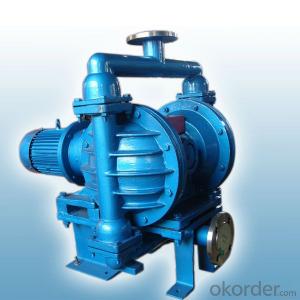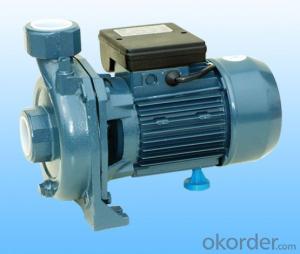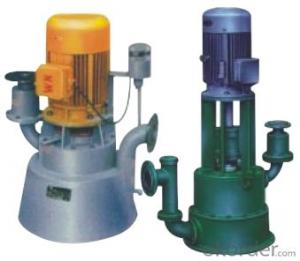SPGB SERIRES Shielding explosion-proof pump
- Loading Port:
- Shanghai
- Payment Terms:
- TT OR LC
- Min Order Qty:
- 10 unit
- Supply Capability:
- 300 unit/month
OKorder Service Pledge
OKorder Financial Service
You Might Also Like
A, product overview
SPGB type completely without leakage blocking pipeline centrifugal pump series, the company is using Japanese technology, and absorb the shielding pump design and manufacture of professional international advanced technology, digestion and innovation of science and technology personnel, by our company newly launched the second generation of shielding pump product, this product is on the basis of the original improved electromagnetic core technology, improve the state of fluid motion, improve the efficiency by more than 10%, a higher level comprehensive performance index is more, the product is more ideal.
SPGB type shield pump is a pump motor and pump integrated structure products, advanced technology, static seal, no shaft seal, reliable performance is high, be totally without leakage, because of its low noise motor itself, together with shielding pump low failure rate, safe environmental protection, and the best maintenance cost advantages, such as wins the general customers, high quality for the Chinese market at the same time enhance the demand of the water pump.
Products are widely used in petrochemical, chemical industry, medicine, textile, nuclear power, military industry, shipbuilding and urban water supply and drainage, fire fighting pump, pressurized water supply in high-rise building, garden sprinkler irrigation, cold and hot water circulation pressurization in hvac refrigeration, etc.Particularly high requirements for vibration and noise, such as key project, pump room, central air conditioning and academy, and so on.Can also be used to transport pressure and does not produce crystallization and solidification temperature of the liquid.Especially harmful to the human body and the environment and unsafe liquid or liquid and so on.
SPGB type pump can also play an important role on more projects, has also been the praise of users.
Second, the product features
Type 1, SPGB shielding pump for can guarantee no leakage, it can transport to the human body and environment, harmful volatile and expensive equipment leakage of liquid.
2, not to inhale air, suitable for vacuum system and metamorphic fluid conveying is exposed to air.
3, without oil seal design, can reliably conveying pump is difficult to transport of high temperature, high pressure, low temperature and the change of temperature and pressure of liquid.
4, bearing using conveying fluid lubrication by oneself, do not need lubricating oil, so no pollution conveying liquid, and dispense with the trouble that oil on a regular basis.
5, the structure of the pump is reasonable, the motor and pump coaxial, small volume, light weight, cover an area of an area small, stable operation, easy installation, no need to adjust, convenient maintenance, do not need to adjust, easy maintenance.
6, impeller adopts water thrust balance type design, make the rotor can be in the running in the suspension design, reduces the axial wear of graphite bearing, so as to improve the service life and reduce the operation cost.
7 no cold to fan, motor, so the running noise and vibration is very small.
8, pump import and export of the specifications of the flange design and standard valves are the same, and in the same center line, the center is low, easy to pipeline layout, pump room design is also reasonable and practical.
9, the standardization of parts, high degree of serialization.
10, junction box adopts waterproof structure, can be used in outdoor security.
11, according to the requirement, that is, the flow and head of the pump series, in parallel operation mode.
12, new USES of graphite bearing, high wear resistance, low friction coefficient, not aging, silt, etc.
Three, use the product
Type 1, SPGB shielding pump can transport clean water and physical and chemical properties similar to other liquid Yu Qingshui, suitable medium temperature - 30 ℃ to + 90 ℃.Particularly applicable to industrial and urban water supply and drainage, fire pressurization, high-rise building construction pressurized water, garden sprinkler irrigation, long-distance transmission of hvac refrigeration cycle, cold and hot water circulation pressurization in the bathroom, etc, and form a complete set of equipment.
Type 2, SPGR heat shielding pump occasions for the medium temperature is higher, suitable for medium temperature 100 ℃ to 380 ℃.Mainly applied to energy, metallurgy, chemical industry, textile, paper making, textile and hotel, restaurant, bathroom etc.
3, SPGT anti-corrosion type pump can transport not containing solid particles, suitable for petrochemical, chemical, metallurgy, electric power, papermaking, food, pharmaceutical research institutions and synthetic fibre and other departments.
4, the circle of SPGN inverse shielding pump for conveying liquid gas, liquefied petroleum gas medium.
Fourth, working conditions
1, medium must be soft water, thin, solidify, nonflammable, fluid containing no solid particles and fibers.
Type 2, SPG pump medium temperature not to exceed 90 degrees, SPGR type pump medium temperature not to exceed 380 degrees.
3, general system working pressure is less than 1.2 mpa, inlet pressure not less than 0.05 mpa, special occasions you should contact with the company in advance.
4, the highest pressure 1.6 MPa SPG shielding pump system, namely the pump suction + pump ≦ 1.6 MPa
- Q: How much air pressure can an air pump generate?
- The generation of air pressure by an air pump relies on various factors, including the pump's type, size, power source, and intended use. Different air pumps are designed to meet specific pressure requirements. For example, compact and portable air pumps used for inflating tires or inflatable toys typically produce air pressure ranging from 30 to 100 PSI, which is adequate for these purposes. Conversely, larger industrial air pumps meant for heavy-duty applications, such as powering pneumatic tools or machinery, can generate significantly higher pressures, reaching 100 to 200 PSI or even more. It is crucial to note that manufacturers usually specify the maximum air pressure a pump can generate, which can be found in the product specifications or user manual. Adhering to these guidelines is essential to ensure the safe and efficient operation of the air pump, preventing damage or accidents resulting from exceeding the recommended pressure limits.
- Q: How is three-phase air pump changed into single phase?
- Take one by one between the two voltage 400 volt electrodeless capacitor, and a power single-phase capacitor motor with no other line, a power capacitor connected to either end (forward or backward), the capacity of the capacitor according to the motor power selection (refer to electrical manual, such as one thousand Duowayue capacitance to 400 V, 20uf) at this time, the motor output power is only 55% of the original, the original work can only reach half the maximum pressure. I practice to help people change the connection, very simple, very successful.
- Q: Can an air pump be used for inflating air sofas with built-in cup holders?
- Yes, an air pump can be used for inflating air sofas with built-in cup holders.
- Q: Can an air pump be used for inflating air tents?
- Yes, an air pump can be used for inflating air tents. Many air tents are designed to be inflated using an air pump, which can make the setup process much quicker and easier compared to traditional pole tents. The air pump supplies a constant flow of air into the tent's inflatable beams, which quickly and efficiently inflate the structure. This eliminates the need for manual assembly and allows for a hassle-free camping experience. However, it is important to ensure that the air pump is compatible with the specific air tent model to prevent any damage or inefficiencies during inflation.
- Q: What are the noise levels of different air pump models?
- The noise levels of different air pump models can vary significantly depending on the specific model and brand. Some air pumps may produce minimal noise, barely noticeable to the human ear, while others may generate a moderate level of noise that is still tolerable. However, there are also some air pumps that can be quite loud, emitting a noticeable humming or buzzing sound. It is important to note that noise levels can also be influenced by factors such as the overall quality of the air pump, the type of motor used, and the environment in which it is installed. Therefore, it is recommended to research and read customer reviews or consult with experts to determine the noise levels of specific air pump models before making a purchase.
- Q: What's the difference between a filter and an oxygen pump? Can a fish filter be used only?
- Yes, but you can't keep a lot of fish. Otherwise, the fish will suffer from oxygen deficiency
- Q: Can an air pump be used for powering air rifles for shooting competitions?
- No, an air pump cannot be used for powering air rifles in shooting competitions. Air pumps are typically used to inflate objects such as inflatable mattresses or sports balls, and do not generate sufficient pressure to propel pellets or bullets in air rifles. Air rifles require specialized systems such as pre-charged pneumatic (PCP) or spring-powered mechanisms to generate the necessary force for shooting projectiles accurately.
- Q: How to install an air pump in an aquarium?
- To install an air pump in an aquarium, follow these steps: 1. Choose a suitable air pump based on the size of your aquarium and the number of air outlets needed. 2. Place the air pump in a dry and elevated location near the aquarium. 3. Attach an air tubing to the outlet of the air pump and connect the other end to an air stone or air diffuser. 4. Position the air stone or diffuser in the desired location within the aquarium. 5. Plug in the air pump to a power source and ensure it is securely connected. 6. Adjust the airflow using the control valve, if applicable, to achieve the desired level of aeration. 7. Regularly maintain and clean the air pump to ensure optimal performance and longevity.
- Q: Can an air pump be used for inflating inflatable water trampolines?
- Yes, an air pump can be used to inflate inflatable water trampolines.
- Q: How does an air pump handle different warranty options?
- An air pump typically offers different warranty options based on the manufacturer's policy and the specific model. These options may vary in terms of coverage duration, conditions, and additional services. Customers can choose the warranty option that best suits their needs and budget, ensuring proper protection and peace of mind for their air pump investment.
Send your message to us
SPGB SERIRES Shielding explosion-proof pump
- Loading Port:
- Shanghai
- Payment Terms:
- TT OR LC
- Min Order Qty:
- 10 unit
- Supply Capability:
- 300 unit/month
OKorder Service Pledge
OKorder Financial Service
Similar products
Hot products
Hot Searches
Related keywords


















